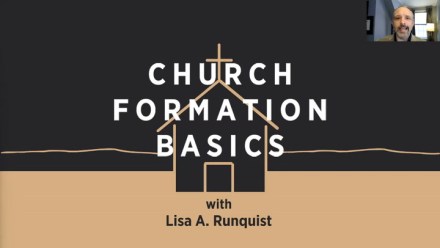Whether you’re casting a vote, taking a vote, or calculating a vote at a church business meeting, it is valuable for both members and leaders to understand the voting process and feel confident about how the result of a vote is determined.
To equip you with the skills needed to take and count a valid vote, this article will explain the four primary voting methods and define three important terms.
What are the different methods of taking a vote?
There are four primary methods for taking a vote: general consent, voice, raised hand or standing, and ballot. No one voting method is inherently better than another although some tend to work better than others in certain circumstances.
First, it is important to understand that no vote must be counted or be secret unless a group has decided that a count or a secret ballot should be used for a specific vote or category of votes.
- For example, a church’s bylaws may include a provision that requires all elections to be conducted by ballot. If so, all election votes will necessarily be counted and secret, even if only one person is running.
- Or, a church may decide at a business meeting that it wants (or needs) a record of the number of votes in favor of or opposed to a specific motion rather than simply a record of whether the motion passed or failed.In that case, the members would need to take a vote directing that the vote on the substantive motion be counted. Unless the members give that type of directive, votes do not need to be counted, even if they are taking a vote by raised hand or by standing.
The rationale here is that counting votes takes time, and a group’s time shouldn’t be used to count votes unless the group has agreed to it.
Here, then, are the primary methods for voting.
Voting Method #1: General or unanimous consent vote
A general consent or unanimous consent vote is a vote used for decision-making on noncontroversial matters. The goal of taking a vote by unanimous consent is efficiency. This type of vote skips the discussion portion of the motions process and eliminates the need for the chairperson to say, “All those in favor. … All those opposed. …” Instead, the chairperson can simply ask if there are any objections to the action proposed by the motion.
For example, if the proposed action is approval of the meeting agenda, the chairperson would ask, “Are there any objections to approving the meeting agenda as distributed?”
After pausing briefly (three to five seconds) to listen for any objections, the chairperson would then say, “Hearing none, the agenda is approved as distributed,” and would move to the next item of business. If there is an objection, the chairperson would say, “There is an objection,” and would move to the discussion portion of the motions process as described here.
Voting Method #2: Voice vote
A voice vote asks members to state whether they are in favor of or opposed to a motion by saying “aye” or “no.” When taking this type of vote, the chairperson determines the winner by listening to which side is louder.
Sometimes, there is need for clarification of the results of this type of vote.
- If the result is not clear to the chairperson, he or she can retake the vote by asking the members to raise their hands or stand (the next voting method listed in this article). If necessary, the chairperson can take a count of the vote.
- If the result is clear to the chairperson but not to one or more of the members, a member can call out, “Division,” which is the parliamentary procedure term for requesting that the chairperson retake the vote by another method that more clearly indicates the result.
This scenario is not uncommon, especially in a large group, because an individual may be sitting in a section of the room in which the side (ayes or noes) that is louder differs from the side that is louder overall.
As discussed above, calling out “Division” does not require a counted vote—a raised hand or standing vote can clarify the result.
Voting Method #3: Raised hand or standing vote
A raised hand or standing vote is a good way to take a vote if the results are too close to call through a voice vote, or if a counted vote is needed or required. This is also a helpful method for taking votes when individuals with voting privileges are seated together with individuals who do not have voting privileges.
For example, some churches allow visitors or regular attenders to stay for business meetings or may allow families to attend business meetings even if not all of them are members. Taking a voice vote in this type of setting may not allow for confidence in the result, especially if the result is close. A raised hand or standing vote can provide a good alternative.
A raised hand or standing vote can be easily counted by having the members count off, starting at the front of the room and working row by row to the back. The chairperson or a teller (a designated vote counter) can cue the first person in the front row to say “1” and lower their hand or sit down, and then cue the person next to them to say “2” and lower their hand or sit down—working all the way through the room until all votes have been counted.
This may sound time consuming, but it doesn’t take much, if any, more time than having a teller go row by row and count all of the votes. The advantage is that the members are involved in the counting and are less inclined to question whether the votes have been accurately tabulated.
Voting Method #4: Ballot vote
A ballot vote is a secret vote by default unless the bylaws require that a ballot be signed. Ballots are generally used for elections and votes on very consequential matters (e.g., a vote to consider a large expense, dissolve a church, merge with another church, or ask an individual to be a pastor, and so on).
When ballot votes are counted, at least two tellers should work together to count them. In the case of an election, each candidate may appoint one representative in addition to the tellers to oversee the counting.
After the ballots are counted, the tellers should prepare a report that includes the total number of ballots cast, the number of votes necessary for election or for adoption of a motion, and the number of votes received by each candidate or votes in favor and opposed to a motion.
The tellers should give the report to the chairperson for announcement of the results and give the ballots to the secretary or a designated person to keep until the time for ordering a recount has passed.
What do the terms majority, two-thirds, and plurality mean?
Various terms are commonly used within bylaws to describe the number of votes needed for a motion to be adopted or for an individual to be elected. It’s important to know the requirements for each vote taken and how to calculate results for that type of vote.
Majority vote
In voting contexts, the term majority is defined as more than half. If a church’s governing documents or rules use the term majority without qualification, the baseline or denominator from which a majority is calculated is the number of votes cast. For example, if 120 individuals are present, but only 100 individuals cast a vote, at least 51 votes would be required for the adoption of the proposal.
Qualifiers can be added to the term majority, however, to change the calculation. For example, to adopt any proposal or to adopt proposals on certain topics, governing documents can require a majority of those present or a majority of the entire membership.
Two-thirds vote
In voting contexts, the term two-thirds generally means at least two-thirds of the individuals present and voting. But as with the term majority, two-thirds can be qualified to mean at least two-thirds of the individuals present or at least two-thirds of the entire membership.
It is also important to understand that two-thirds is not necessarily the same as 66.6 percent or 67 percent. The best way to calculate two-thirds is to multiply the total number of individuals of which two-thirds is needed times 2, then divide that number by 3, and then round the result to the nearest whole number.
Plurality
The term plurality means more votes than any other option but not enough votes to constitute a majority. Here’s an example of a plurality vote calculation: Three candidates are running for office. There are 100 members present and voting. Candidate #1 receives 40 votes; candidate #2 receives 41 votes; candidate #3 receives 19 votes. If bylaws specify that the winning candidate must receive a plurality of the votes, candidate #2, in this case, would be the winner.
Return to the series homepage.
For related infographics and downloadable resources from the author, visit The Law of Order blog at civility.co.
Sarah E. Merkle is a professional parliamentarian and presiding officer. One of five lawyers worldwide to have earned the credentials Certified Professional Parliamentarian-Teacher (CPP-T) and Professional Registered Parliamentarian (PRP), she helps boards, associations, corporations, and public bodies navigate rules applicable to governance and business meetings.












